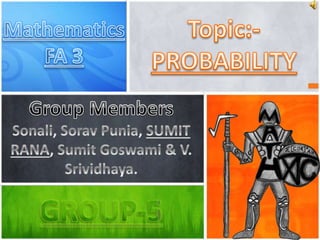Mathematics PROBABILITY !!!!!!!!
The document provides information about probability theory and its history. It discusses how probability theory originated in the 16th century with the first book on the subject written by an Italian physician. It then describes some of the major mathematicians like James Bernoulli, Abraham de Moivre, and Pierre-Simon Laplace who made significant contributions to developing the field of probability theory. More recently, probability has been applied extensively in various areas like biology, economics, genetics, and physics. The document also provides basic definitions and properties of probability like how to calculate the probability of an event and the complement of an event. It includes some examples demonstrating how to calculate probabilities.

Recommended
Recommended
More Related Content
What's hot
What's hot (20)
Viewers also liked
Viewers also liked (10)
Similar to Mathematics PROBABILITY !!!!!!!!
Similar to Mathematics PROBABILITY !!!!!!!! (20)
Recently uploaded
Recently uploaded (20)
Mathematics PROBABILITY !!!!!!!!
- 2. PROBABILITYThe Greater the Probability the more likely the event will occur. PROBABILITY of any EVENT is between 0 and 1. SUM of ALL Probabilities of ANY event is 1. Basic’s about Probability ISTHE MATHEMATICS OF CHANCE
- 3. HISTORYOF PROBABILITY PROBABILITY THEORY HAD ITS ORIGIN IN THE 16TH CENTURY WHEN AN ITALIAN PHYSICIAN AND MATHEMATICIAN J CARDAN WROTE THE FIRST BOOK ON THE SUBJECT, THE BOOK ON GAMES OF CHANCE. SINCE ITS INCEPTION, THE STUDY OF PROBABILITY HAS ATTRACTED THE ATTENTION OF GREAT MATHEMATICIANS, JAMES BERNOULLI (1654-1705), A. DE MOIVRE (1667-1754) AND PIERRE SIMON LAPLACE ARE AMONG THOSE WHO MADE SIGNIFICANT CONTRIBUTIONS TO THE FIELD, LAPLACE’S THEORIE ANALYTIQUE DES PROBABILITIES, 1812, IS CONSIDERED TO BE THE GREATEST CONTRIBUTION BY A SINGLE PERSON TO THE THEORY OF PROBABILITY. IN RECENT YEARS, PROBABILITY HAS BEEN USED EXTENSIVELY IN MANY AREAS SUCH AS BIOLOGY, ECONOMICS, GENETICS, PHYSICS, SOCIOLOGY ETC. MATHEMATICIAN LAPLACE
- 4. THEORITICAL Probability Notation: The probability that Event E will occur is written P(E) and is read “the probability of event E.” The Probability of an Event, E: Consider a pair of Dice Each of the Outcomes in the Sample Space are random and equally likely to occur. P(E) = Number of Event Outcomes Total Number of Possible Outcomes in S e.g. P( ) = (There are 2 ways to get one 6 and the other 4) 18 1 36 2
- 5. The Complement of Event E is the set of all outcomes in a sample space that are not included in Event E. The Complement of event E is denoted by Properties of Probability: EorE COMPLIMENTRY Event )(1)( )(1)( 1)()( 1)(0 EPEP EPEP EPEP EP
- 7. CARDS RED (26) BLACK (26) OTHER CARD’S FOR ALL:- ACE,2,3,4,5,6,7,8,9,10
- 8. NOW LET’S TRY OUT SOME EXAMPLES A Dice is thrown, then find out:-
- 9. Two customers Shyam and Ekta are visiting a particular shop in the same week (Tuesday to Saturday). Each is equally likely to visit the shop on any day as on another day. What is the probability that both will visit the shop on (i) the same day? (ii) consecutive days? (iii) different days?
- 10. A die is numbered in such a way that its faces show the number 1, 2, 2, 3, 3, 6. It is thrown two times and the total score in two throws is noted. Complete the following table which gives a few values of the total score on the two throws: What is the probability that the total score is (i) even? (ii) 6? (iii) at least 6? + 1 2 2 3 3 6 1 2 3 3 4 4 7 2 3 4 4 5 5 8 2 3 4 4 5 5 8 3 4 5 5 6 6 9 3 4 5 5 6 6 9 6 7 8 8 9 9 12 Total number of possible outcomes when two dice are thrown = 6 × 6 = 36 (i) Total times when the sum is even = 18 P (getting an even number) (ii) Total times when the sum is 6 = 4 P (getting sum as 6) (iii) Total times when the sum is at least 6 (i.e., greater than 5) = 15 P (getting sum at least 6)
- 11. A bag contains 5 red balls and some blue balls. If the probability of drawing a blue ball is double that of a red ball, determine the number of blue balls in the bag. Let the number of blue balls be x. Number of red balls = 5 Total number of balls = x + 5 P (getting a red ball) P (getting a blue ball) Given that, However, the number of balls cannot be negative. Hence, number of blue balls = 10
- 12. A box contains 12 balls out of which x are black. If one ball is drawn at random from the box, what is the probability that it will be a black ball? If 6 more black balls are put in the box, the probability of drawing a black ball is now double of what it was before. Find x. Total number of balls = 12 Total number of black balls = x P (getting a black ball) = If 6 more black balls are put in the box, then Total number of balls = 12 + 6 = 18 Total number of black balls = x + 6 P (getting a black ball now) According to the condition given in the question,
- 27. ACKNOWLEDGEMENT
Editor's Notes
- Breaking your dependence on your slides can do a world of good for your relationship with your audience.